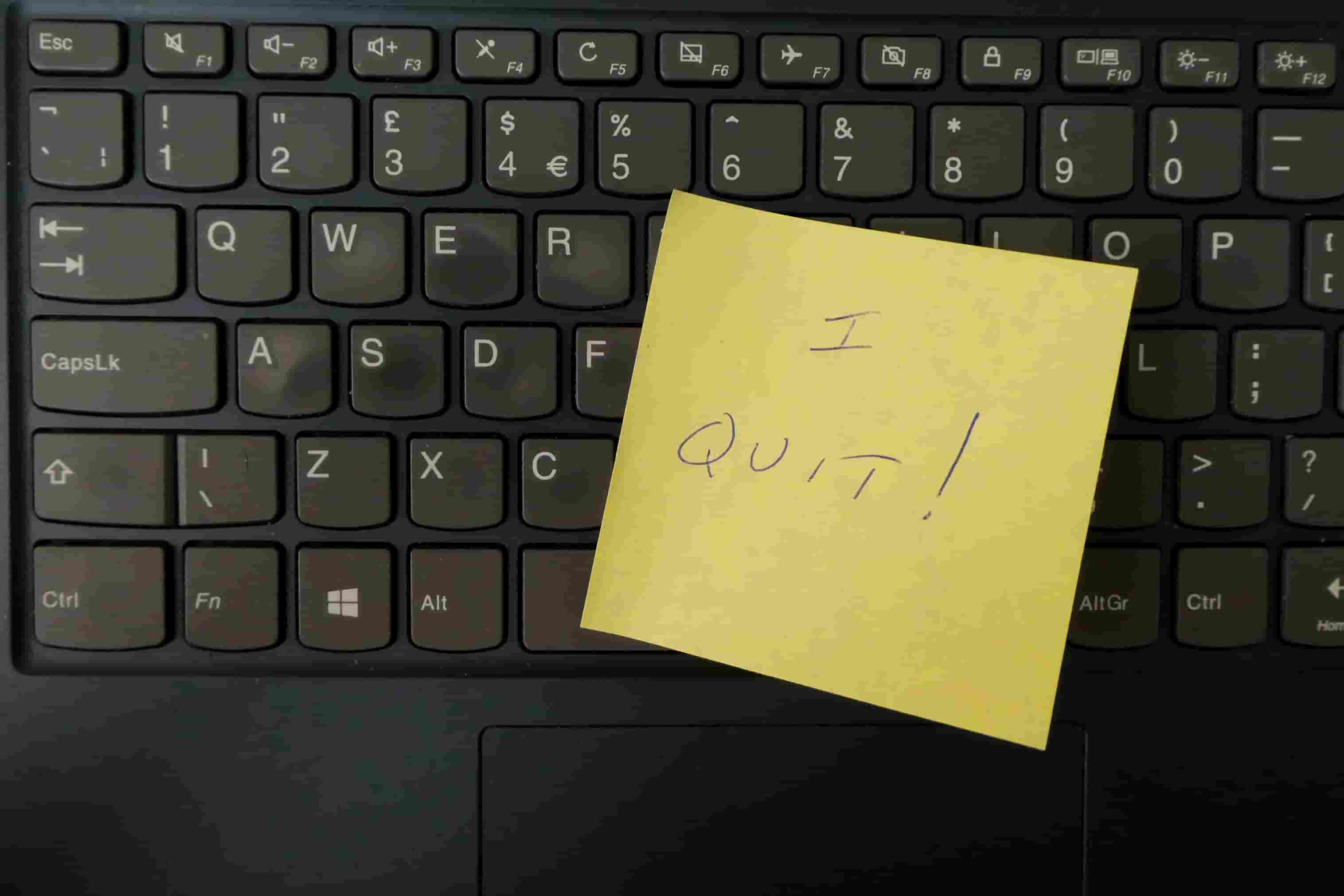Resigning from a job can feel like navigating uncharted waters and the process can be filled with mixed emotions. From the relief of moving on to new opportunities, to the nervousness of venturing into the unknown, to the bittersweet realization of leaving your colleagues behind—it’s a big step. One of the key parts of this process is writing a resignation letter, a task that can seem daunting if you’ve never done it before.
In the world of professional etiquette, how you exit a remote job can be just as important as how you entered it. A well-crafted resignation letter serves as your official notice of departure, helping to ensure the transition happens as smoothly as possible. It’s an opportunity to maintain your professional reputation, and to leave on good terms with your soon-to-be former employer.
In this blog post, we’ll walk you through how to write a resignation letter for a remote job that is professional, respectful, and considerate, ensuring you exit with the same grace and dignity you’ve demonstrated throughout your tenure. Let’s cover everything from what to include (and what not to), to giving you step-by-step instructions and an easy-to-use template.
What is a Resignation Letter?
A resignation letter is a formal written notice to an employer indicating an employee’s intention to leave their current job. This letter serves as official documentation of the employee’s decision to end their employment and typically includes the planned last day of work, commonly giving at least two weeks’ notice as per most professional standards.
A resignation letter can also serve as an opportunity for an employee to express gratitude for the experiences and opportunities they had during their tenure, share the reason for their departure, and offer assistance for the transition period, such as training a replacement or finalizing ongoing projects.
It’s important to note that a resignation letter is usually part of a larger resignation process, which might include a face-to-face conversation with a supervisor or an exit interview. The resignation letter provides a written record of the decision to resign, and can help maintain a positive relationship between the employee and the employer, which is beneficial for future references and networking.

The Key Elements of a Resignation Letter
A resignation letter should include several key elements to effectively and professionally communicate your intention to leave your current position. Here they are:
1. Contact Information: At the top of your letter, include your name, address, phone number, and email address. Then, write the date when you’re writing the letter. Below that, include the recipient’s name (your boss or the HR representative), their title, and the company’s address.
2. Formal Salutation: Begin the letter with a formal greeting, such as “Dear [Your Manager’s Name],”
3. Statement of Resignation: Clearly state your intent to resign. This should include your current position and the name of the company to avoid any confusion.
4. Last Working Day: Specify the effective date of your resignation. It’s customary to give at least two weeks’ notice, but this might vary depending on your employment contract or company’s policy.
5. Reason for Leaving (Optional): You may choose to briefly explain your reason for leaving. However, keep this section concise and professional. You don’t need to go into detail, particularly if the circumstances of your departure are complicated or sensitive.
6. Expression of Gratitude: Thank your employer for the opportunities and experiences you had while working there. Regardless of your reasons for leaving, aim to highlight some positives from your time at the company.
7. Offer of Assistance: If possible, offer to help facilitate the transition process. This might include training your replacement, documenting your duties and ongoing projects, or any other relevant tasks.
8. Professional Closing: Conclude your letter with a professional sign-off, such as “Sincerely” or “Best Regards,” followed by your full name.
9. Signature: Sign your name at the end of the letter, below the closing.
Keep in mind, the resignation letter should be concise, clear, and professionally composed, as it will likely be included in your employee records. It’s best to leave on good terms and maintain positive relationships with your former employers and colleagues.

What to include in a Resignation Letter?
A resignation letter should be clear, concise, and include the following components:
1. Header: Just like any formal letter, begin with your name, address, and the date. Following this, write your employer’s name and address.
2. Formal salutation: Start your letter with a formal greeting, such as “Dear [Your supervisor’s name],”
3. Statement of resignation: This is where you clearly state your intention to resign from your current position. It’s good practice to specify your current role and the name of the organization.
4. Last working day: Mention the effective date of your resignation. The standard is to give a two-week notice, but this could vary depending on the company’s policy or the terms of your employment contract.
5. Reason for leaving (optional): If you wish, you can include the reason for your departure. Be straightforward and respectful, even if you’re leaving under less-than-ideal circumstances. Remember, it’s best to focus on the positives wherever possible.
6. Express gratitude: Regardless of your experiences at the job, try to include a few lines expressing gratitude for the opportunity. Highlighting the skills or experience you gained can contribute to leaving on a positive note.
7. Offer assistance during the transition: If possible, offer to help during the transition period. This could include training a replacement or finishing up certain tasks before your departure.
8. Formal closing: Close the letter professionally with phrases like “Sincerely” or “Best Regards,” followed by your typed and signed name.
Remember to keep the letter succinct and positive. It’s not necessary to go into detail about potential issues or problems. The key is to leave on the best possible terms to maintain your professional reputation and relationships.

What not to include in your Resignation Letter?
While a resignation letter is your official way of communicating your departure from a company, there are several things that it is generally better not to include:
- Negative or disparaging comments: Even if you’re leaving because you’re unhappy, it’s not a good idea to include criticisms of your boss, coworkers, or the company in your resignation letter. Remember that this document can be stored and referred to in the future, so you don’t want to burn any bridges.
- Detailed reasons for leaving: Unless the reason for leaving is a positive one (e.g., moving for family reasons, pursuing further studies, or a new job opportunity), you don’t need to go into detail about why you’re resigning. If the reasons are negative, they’re better discussed face-to-face.
- Personal criticisms or complaints: Similar to the first point, airing grievances about specific people or incidences can come off as unprofessional. Keep the tone of your letter positive and forward-looking.
- Too much personal information: While it’s okay to share broad reasons for your resignation, like taking care of your health or family, there’s no need to divulge too much personal information. Keep the letter professional.
- False flattery or insincere positivity: Be genuine in your sentiments. If your experience wasn’t overwhelmingly positive, it’s okay to express simple thanks for the opportunity and the experience gained.
- Negotiable terms: Your resignation letter is not the place to negotiate exit terms, like severance pay or unused vacation time. These matters are better discussed in person or with a representative from Human Resources.
Remember, the key goal of your resignation letter is to inform your employer about your decision to leave the company, while maintaining professionalism and respectfulness. This document will remain in your employment record, so you want to ensure it reflects well on you.

How to Write a Resignation Letter?
Here a step-by-step guide on how to write a professional resignation letter:
- Start with a formal header: Include your name, address, the date, and the recipient’s name and address, similar to any formal business letter.
- Address your supervisor or boss: Use a formal salutation such as “Dear Mr./Ms./Dr. [Last name],”
- State your intent to resign: In the first paragraph, clearly state that you are resigning and include the date of your last working day. It’s standard to give at least two weeks’ notice, but check your contract or company’s policy.
- Explain the reason (optional): You can include a brief explanation of why you are leaving, if you’re comfortable doing so. However, this isn’t necessary, and it’s advisable to avoid negativity or complaints.
- Express gratitude: Spend a few sentences thanking your employer for the opportunities and experience you’ve gained while working there. This helps maintain good relationships and leave on a positive note.
- Offer assistance for the transition period: If appropriate, offer to assist with any transition tasks such as training a replacement or completing outstanding work.
- Conclude the letter: Use a polite closing line such as “Sincerely” or “Best regards,” followed by your name. You may also include your contact information if it’s not already listed at the top of the letter.
- Proofread: Carefully check your letter for grammar and spelling errors. Make sure the tone is professional and respectful throughout.
Resignation Letter Template
Dear [Recipient’s Name],
I am writing to formally announce my resignation from [Your Position] at [Company’s Name], effective [your last day—typically two weeks from the date you’re writing the letter].
During my time at [Company’s Name], I have greatly appreciated the opportunities to grow and develop professionally and personally. It has been a pleasure to work for [Company’s Name] and to be part of such a dynamic team.
The decision to leave was not easy, but I have accepted a position that aligns more closely with my long-term career goals. I believe this move is in the best interest of my career growth and personal development.
I am committed to making this transition period smooth and will do everything possible to ensure that my responsibilities are adequately covered. I am willing to assist in the training of my replacement or pass on my responsibilities to a designated colleague.
I want to express my deepest gratitude for the opportunity to serve in [Company’s Name] and for the professional relationships that I have built. I look forward to maintaining these relationships as I move to the next stage of my career.
Thank you for your understanding, and for the valuable experience I have gained during my employment. I am confident that [Company’s Name] will continue to prosper and I wish you all the best in your future endeavors.
Sincerely,
[Your Name]
Remember, it’s essential to tailor this template to your specific circumstances and the culture at your company. Being polite and professional in your resignation letter will help you leave on good terms and maintain valuable professional relationships.
Conclusion
Crafting a professional and respectful resignation letter is a crucial part of the resignation process. It not only formally communicates your intention to leave but also helps maintain positive relationships with your employer and colleagues. No matter what your reasons for resigning may be, your letter should be brief, clear, and focused on leaving a positive impression.
Remember, the key elements to include in your resignation letter are your formal declaration of resignation, the date of your last working day, your reason for leaving (if you choose to include it), your expression of gratitude, and your willingness to assist with the transition.
By using our guidelines and the provided template, you should be able to create a resignation letter that professionally communicates your intent. While moving on from a job can be a challenging time, a well-written resignation letter can ensure a smooth transition and maintain your professional reputation.
As the saying goes, “Don’t burn bridges” – you never know when you might need a reference, or when your paths might cross with your former employer in the future. Good luck with your new journey!
Go over our guide to see how companies hire remote employees and learn essential qualities a remote employee must have, if you are looking for a new job. When searching for a remote job, study these common questions remote workers usually ask.. And while you’re at it, join like-minded remote workers in our LinkedIn community.
If you are searching for your next remote job and need help figuring out where to look. DailyRemote is a remote job board with the latest jobs posted in various categories, such as software development, marketing, virtual assistant jobs, etc.


